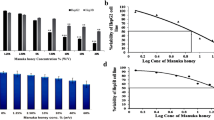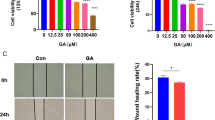Abstract
Protein kinase C (PKC) is a key regulator of cell growth and differentiation in mammalian cells and hyperactivation of PKC is believed to play an important role in tumor progression. PKC is downstream to signaling protein of phosphatidylinositol 3-Kinase (PI3K), a known up-regulator of cell proliferation and survival. Accumulation of reactive oxygen species (ROS) triggers oxidative stress in the tumor microenvironment, leading to the hyperactivation of various oxidative stress-stimulated signaling molecules. Quercetin (QUE) is a naturally occurring dietary flavonoid having antioxidant properties. QUE is reported to show antitumor activity both in vitro and in vivo; however, the molecular mechanism is yet to be thoroughly explored. HepG2 cells display cellular functions similar to the normal hepatocytes with high degree of morphological and functional differentiation, therefore HepG2 cell line is chosen as the suitable model for drug targeting. Present study is aimed to establish the signaling pathway involved in the anticarcinogenic action of QUE in HepG2 cell line. HepG2 cells were treated with different doses of QUE. Protein level and gene expression were analysed by Western blotting and RT-PCR, respectively. PKC activity was measured by non-radioactive-tagged phosphorylation. Results showed downregulation of expression of PI3K, PKC, COX-2 and ROS caused by QUE. Additionally, QUE enhanced the expression of p53 and BAX in HepG2 cells. Overall, results of the current study suggested that QUE elicited anticarcinogenic action by upregulation of p53 and BAX in HepG2 cells via downregulation of ROS, PKC, PI3K and COX-2, confirming our earlier report on the animal model.









Similar content being viewed by others
References
Raza A, Sood GK (2005) Hepatocellular carcinoma review: current treatment, and evidence-based medicine. World J Gastroenterol 20(15):4115–4127
Villanueva A, Minguez B, Forner A, Reig M, Llovet JM (2010) Hepatocellular carcinoma: novel molecular approaches for diagnosis, prognosis and therapy. Annu Rev Med 61:317–328
Kanadaswami C, Lee LT, Lee PPH, Hwang JJ, Ke FC, Huang YT, Lee MT (2005) The antitumor activities of flavonoids. In Vivo 19:895–910
Batra P, Sharma AK (2013) Anti-cancer potential of flavonoids: recent trends and future perspectives. 3. Biotech 3:439–459
Yao H, Xu W, Shi X, Zhang Z (2011) Dietary flavonoids as cancer prevention agents. J Environ Sci Health C 29:1–31
Shanmugam MK, Kannaiyan R, Sethi G (2011) Targeting cell signaling and apoptotic pathways by dietary agents: role in the prevention and treatment of cancer. Nutr Cancer 63(2):161–173
Verma N, Vinayak M (2009) Effect of Terminalia arjuna on antioxidant defense system in cancer. Mol Biol Rep 36:159–164
Maurya AK, Vinayak M (2015) Quercetin regresses Dalton’s lymphoma growth via suppression of PI3K/AKT signaling leading to up regulation of p53 and decrease in energy metabolism. Nutr Cancer 67(2):354–363
Choi KC, Chung WT, Kwon JK, Yu JY, Jang YS, Park SM, Lee SY, Lee JC (2010) Inhibitory effects of quercetin on aflatoxin B1-induced hepatic damage in mice. Food Chem Toxicol 48:2747–2753
Ferry DR, Smith A, Malkhandi J, Fyfe DW, Detakats PG (1996) Phase I clinical trial of the flavonoid quercetin: pharmacokinetics and evidence for in vivo tyrosine kinase inhibition. Clin Cancer Res 2:659–668
Harwood M, Nikiel BD, Borzelleca JF, Flamm GW, Williams GM (2007) A critical review of the data related to the safety of quercetin and lack of evidence of in vivo toxicity, including lack of genotoxic/carcinogenic properties. Food Chem Toxicol 45:2179–2205
Dehn PF, White CM, Conners DE, Shipkey G, Cumbo TA (2004) Characterization of the human hepatocellular carcinoma (HepG2) cell line as an in vitro model for cadmium toxicity studies. In Vitro Cell Dev Biol Anim 40:172–182
Roe AL, Snawder JE, Benson RW, Roberts DW, Casciano DA (1993) HepG2 cells: an in vitro model for P450-dependent metabolism of acetaminophen. Biochem Biophys Res Commun 190:15–19
Zhao YJ, Ju Q, Li GC (2013) Tumor markers for hepatocellular carcinoma. Mol Clin Oncol 1:593–598
Goya L, Mateos R, Bravo L (2007) Effect of the olive oil phenol hydroxytyrosol on human hepatoma HepG2 cells. Eur J Nutr 46:70–78
Wu WS (2006) The signaling mechanism of ROS in tumor progression. Cancer Metastasis Rev 25:695–705
Sosa V, Moline T, Somoza R (2013) Oxidative stress and cancer: an overview. Ageing Res Rev 12:376–390
Sherr CJ (2004) Principles of tumor suppression. Cell 16:235–246
Trachootham D, Alexandre J, Huang P (2009) Targeting cancer cells by ROS-mediated mechanisms: a radical therapeutic approach. Nat Rev Drug Discov 8:579–591
Trachootham D, Lu W, Ogasawara M (2008) Redox regulation of cell survival. Antioxid Redox Signal 10:1343–1374
Suzuki K, Matsubara H (2011) Recent advances in p53 research and cancer treatment. J Biomed Biotechnol. doi:10.1155/2011/978312
Ristimaki A, Sivula A, Lundin J, Lundin M, Salminen T, Haglund C, Joensuu H, Isola J (2002) Significance of elevated cyclooxygenase-2 expression in breast cancer. Cancer Res 62:632–635
Secchiero S, Barbarotto E, Gonelli A (2005) Potential pathogenetic implications of cyclooxygenase-2 overexpression in B chronic lymphoid leukemia cells. Am J Pathol 167:1599–1607
Sobolewski C, Cerella C, Dicato M, Ghibelli L, Diederich M (2010) The role of cyclooxygenase-2 in cell proliferation and cell death in human malignancies. Int J Cell Biol. doi:10.1155/2010/215158
Subbaramaiah K, Altorki N, Chung WJ, Mestre JR, Sampat A, Dannenberg AJ (1999) Inhibition of cyclooxygenase-2 gene expression by p53. J Biol Chem 274:10911–10915
Gopalakrishna R, Gundimeda U (2002) Antioxidant regulation of protein kinase C in Cancer Prevention. J Nutr 132:3819–3823
Paulsen CE, Carroll KS (2010) Orchestrating redox signaling networks through regulatory cysteine switches. ACS Chem Biol 5:47–62
Aspects D, Giorgi C, Agnoletto C (2010) Redox control of protein kinase C: cell-and disease-specific aspects. Antioxid Redox Signal 13:1051–1085
Caino MC, Meshki J, Kazanietz MG (2009) Hallmarks for senescence in carcinogenesis: novel signaling players. Apoptosis 14:392–408
Mishra S, Vinayak M (2011) Anti-carcinogenic action of ellagic acid mediated via modulation of oxidative stress regulated genes in Dalton lymphoma bearing mice. Leuk Lymphoma 52:2155–2161
Lee SK, Shehzad A, Jung JC (2012) Protein kinase Cα protects against multidrug resistance in human colon cancer cells. Mol Cells 34:61–69
Konopatskaya O, Poole AW (2010) Protein kinase C alpha: disease regulator and therapeutic target. Trends Pharmacol Sci 31:8–14
Wu T-T, Hsieh Y-H, Hsieh Y-S, Liu J-Y (2008) Reduction of PKC alpha decreases cell proliferation, migration, and invasion of human malignant hepatocellular carcinoma. J Cell Biochem 103:9–20
Vanhaesebroeck B, Guibert JG, Graupera M, Bilanges B (2010) The emerging mechanisms of isoform specific PI3K signalling. Nat Rev Mol Cell Biol 11:329–334
Geering B, Cutillas PR, Nock G, Gharbi SI, Vanhaesebroeck B (2007) Class IA phosphoinositide 3-kinases are obligate p85-p110 heterodimers. Proc Natl Acad Sci USA 104:7809–7814
Qian W, Nishikawa M, Haque AM (2005) Mitochondrial density determines the cellular sensitivity to cisplatin-induced cell death. Am J Physiol Cell Physiol 289:1466–1475
Das L, Vinayak M (2014) Long term effect of curcumin in regulation of glycolytic pathway and angiogenesis via modulation of stress activated genes in prevention of cancer. PLoS One 9:1–12. doi:10.1371/journal.pone.0099583
Hayashi A (2006) Effects of daily oral administration of quercetin chalcone and modified citrus pectin on implanted colon-25 tumor growth in balb-c mice. Altern Med Rev 5:546–552
Young JF, Nielsen SE, Haraldsdóttir J, Daneshvar B, Lauridsen ST, Knuthsen P et al (1999) Effect of fruit juice intake on urinary quercetin excretion and biomarkers of antioxidative status. Am J Clin Nutr 69:87–94
Leary KAO, Day AJ, Needs PW, Mellon FA, Brien NMO, Williamson G (2003) Metabolism of quercetin-7- and quercetin-3-glucuronides by an in vitro hepatic model: the role of human β-glucuronides, sulfotransferase, catechol –o-methyl transferase and multi-resistant protein 2 (MRP2) in flavonoid metabolism. Biochem Pharmacol 65:479–491
Boulton DW, Walle UK, Walle T (1999) Fate of the flavonoid quercetin in human cell lines: chemical instability and metabolism. J Pharm Pharmacol 51:353–359
Cohen B, Yoakim M, Wormst HP, Robertst TM, Brian S (1990) Tyrosine phosphorylation is a signal for the trafficking of pp85, an 85-kDa phosphorylated polypeptide associated with phosphatidylinositol kinase activity. Proc Natl Acad Sci USA 87:4458–4462
Walker EH, Pacold ME, Perisic O, Stephens L, Hawkins PT (2000) Structural determinants of phosphoinositide 3-kinase inhibition by wortmannin, LY294002, quercetin, myricetin, and staurosporine. Mol Cell 6:909–919
Mishra S, Vinayak M (2013) Ellagic acid checks lymphoma promotion via regulation of PKC signaling pathway. Mol Biol Rep 40:1417–1428
Mishra S, Vinayak M (2014) Ellagic acid inhibits PKC signaling by improving antioxidant defense system in murine T cell lymphoma. Mol Biol Rep 41:4187–4197
Sharma R, Vinayak M (2012) Antioxidant α-tocopherol checks lymphoma promotion via regulation of expression of protein kinase C-α and c-Myc genes and glycolytic metabolism. Leuk Lymphoma 53(6):1203–1210
Gamet-Payrastre L, Manenti S, Gratacap M-P, Tulliez J, Chap H, Payrastre B (1999) Flavonoids and the inhibition of PKC and PI 3-kinase. Gen Pharmacol 32:279–286
Wu CH, Wu CF, Huang HW, Jao YC, Yen GC (2009) Naturally occurring flavonoids attenuate high glucose-induced expression of proinflammatory cytokines in human monocytic THP-1 cells. Mol Nutr Food Res 53:984–995
Maurya AK, Vinayak M (2015) Modulation of PKC signaling and induction of apoptosis through suppression of reactive oxygen species and tumor necrosis factor receptor 1 (TNFR1): key role of quercetin in cancer prevention. Tumor Biol. doi:10.1007/s13277-015-3634-5
Smith SD, Enge M, Bao W, Thullberg M, Costa TDF, Olofsson H, Gashi B, Selivanova G, Strömblad S (2012) Protein kinase Cα (PKCα) regulates p53 localization and melanoma cell survival downstream of integrin αv in three-dimensional collagen and in Vivo. J Biol Chem 287:29336–29347
Porebska I, Wyrodek E, Kosacka M, Adamiak J, Jankowska R, Ska-Szmyrka AH (2006) Apoptotic markers p53, Bcl-2 and Bax in primary lung cancer. In Vivo 20:599–604
Miyashita T, Krajewski S, Krajewska M, Wang HG, Lin HK, Liebermann DA, Hoffman B, Reed JC (1994) Tumor suppressor p53 is a regulator of bcl-2 and bax gene expression in vitro and in vivo. Oncogene 9(6):1799–1805
Miyashita T, Reed JC (1995) Tumor suppressor p53 is a direct transcriptional activator of human bax gene. Cell 80:293–299
Sun ZJ, Chen G, Hu X, Zhang W, Liu Y et al (2010) Activation of PI3K/Akt/IKK-α/NF-kB signaling pathway is required for the apoptosis-evasion in human salivary adenoid cystic carcinoma: its inhibition by quercetin. Apoptosis 15:850–863
Haghiac M, Walle T (2005) Quercetin induces necrosis and apoptosis in SCC-9 oral cancer cells. Nutr Cancer 53(2):220–231
Lee TJ, Kim OH, Kim YH, Lim JH, Kim S, Park JW, Kwon TK (2006) Quercetin arrests G2/M phase and induces caspase-dependent cell death in U937 cells. Cancer Lett 240:234–242
Acknowledgments
Research was supported by University Grants Commission (UGC), India. AKM thanks Council of Scientific and Industrial Research (CSIR), India, for Junior and Senior Research Fellowship (CSIR Award No. File No: 09/013(0338)/2010-EMR-I).
Author information
Authors and Affiliations
Corresponding author
Rights and permissions
About this article
Cite this article
Maurya, A.K., Vinayak, M. Anticarcinogenic action of quercetin by downregulation of phosphatidylinositol 3-kinase (PI3K) and protein kinase C (PKC) via induction of p53 in hepatocellular carcinoma (HepG2) cell line. Mol Biol Rep 42, 1419–1429 (2015). https://doi.org/10.1007/s11033-015-3921-7
Received:
Accepted:
Published:
Issue Date:
DOI: https://doi.org/10.1007/s11033-015-3921-7




